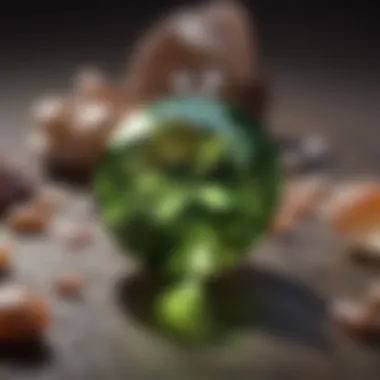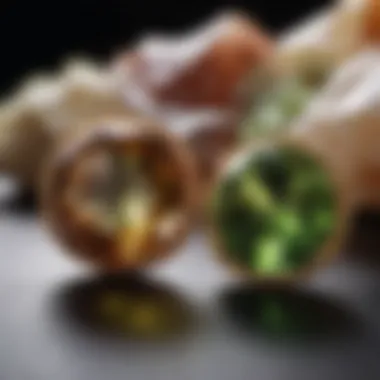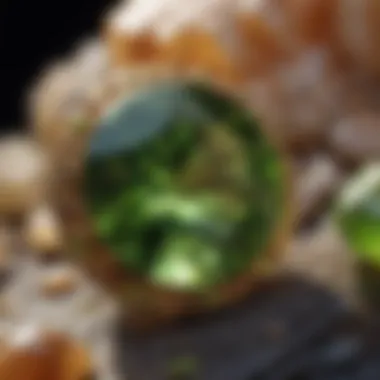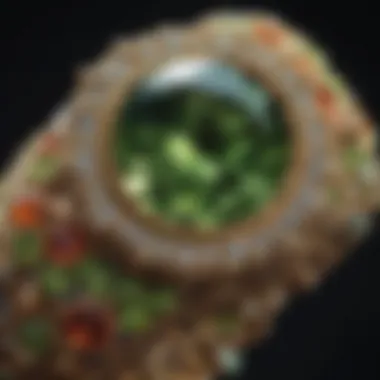The Birthstone of August 23rd: Peridot and Sardonyx


Intro
August 23rd is notable for its unique birthstones: peridot and sardonyx. These gems possess rich histories and captivating characteristics that appeal to gemstone enthusiasts and collectors alike. Understanding their traits, historical contexts, and care methods will enable buyers and jewelry designers to make informed decisions.
Specifically, peridot and sardonyx are each remarkable in their own right. They not only represent aesthetic beauty but also carry significant meaning and value across different cultures and eras. This article aims to delve into their origins and properties, illuminating aspects that enrich appreciation for these stones.
Gemstone Overview
Definition and Origins
Peridot: Peridot is a gem-quality variety of the mineral olivine. Its distinct olive-green hue ranges from pale green to dark green, often with a yellowish tint. The name peridot is derived from the Arabic word "faridat," meaning gem. Peridot has been cherished since ancient times, often associated with light and sun.
Sardonyx: Sardonyx is a layered stone composed of sard and onyx, offering a rich blend of colors, particularly reddish-brown and white. The term is derived from the Greek words "sard" and "onux," which translates to "a nail" or "claw." Sardonyx has been used in jewelry and seals for centuries, valued for both its durability and striking appearance.
Historical Significance
Peridot is known as the birthstone of August, and its roots trace back to ancient Egypt, where it was often referred to as the "gem of the sun." This association emphasized its importance in culture and mythology, believed to bring good luck and ward off evil spirits.
On the other hand, sardonyx has a storied history. It was favored in ancient Rome and Greece, often used for cameos and intaglios. Its layering allowed for intricate designs, making it a preferred medium for artisans. Both stones are rich in symbolism and have held different meanings throughout various periods and societies.
Gemstone Properties
Hardness and Durability
Peridot: Peridot holds a hardness rating of 6.5 to 7 on the Mohs scale. This means it is relatively durable, though it may still be susceptible to scratches and chips if not treated with care.
Sardonyx: Sardonyx is more robust, with a hardness range of 6.5 to 7.5. This durability makes it suitable for various jewelry applications, including rings, where it faces daily wear.
Color and Clarity
Peridot: The color of peridot is often its defining feature. The best stones display a vivid, intense green with minimal color zoning. Clarity can vary, but high-quality peridot is generally transparent with few inclusions.
Sardonyx: Sardonyx is characterized by its banded appearance, typically showcasing rich browns and whites. The clarity of sardonyx can vary, but the layers create a striking visual effect that often enhances a piece's overall aesthetics.
Preamble to August Birthstones
Understanding the birthstones associated with August, particularly on the 23rd, provides more than just aesthetic appeal. Birthstones serve as symbols of identity, heritage, and personal significance. They can also hold various meanings and implications that resonate deeply with individuals. In this article, we focus on peridot and sardonyx, the birthstones for those born in late August. Their unique characteristics distinguish them and reflect diverse cultural and historical narratives, allowing enthusiasts to appreciate them on multiple levels.
Overview of Birthstones
Birthstones have been a part of human culture for centuries. Every month corresponds to specific stones believed to bring good fortune, protection, and prosperity. For those born in August, peridot and sardonyx symbolize strength and resilience. Choosing a birthstone can be a personal journey, as it embodies attributes one may wish to embrace or celebrate.
The visual appeal of birthstones varies. Birthstones can be appreciated for their vibrant colors and unique patterns. For example, peridot shines with its olive-green hues, while sardonyx boasts beautiful bands of color. These stones are not just decorative; they carry stories of the earth, tradition, and the human experience.
Historical Context of Birthstones
The concept of birthstones leans heavily on ancient beliefs. Historical texts, especially the Bible, mention the twelve stones in the breastplate of Aaron, which many scholars link to modern birthstones. Although the list of stones has evolved, the deep historical ties remain relevant. In ancient civilizations, such as the Egyptians and Romans, stones were believed to carry mystical properties and were often consumed or worn as talismans.
The evolution of these beliefs into the modern era shows the enduring fascination with gemstones. Various cultures have adopted different stones for their months, further expanding the meanings attached to them. Each stone’s history tells us about the civilizations that cherished them, enriching our understanding of cultural significance tied to personal identity.
Understanding the nuanced contexts surrounding peridot and sardonyx can deepen one’s appreciation for these remarkable gemstones. They connect us to our roots and often remind us of shared human experiences through times, transcending mere ornamentation.
Peridot: The Primary Birthstone
Peridot, a gemstone with a rich history and notable characteristics, is recognized as the primary birthstone for those born on August 23rd. This vibrant green stone is not just visually stunning but also carries with it a variety of benefits and considerations. Its mesmerizing hue makes it a popular choice in jewelry, but its cultural significance and metaphysical attributes also contribute to its allure.
Physical Characteristics of Peridot


Color Variations
Color variations in peridot are significant. Typically, this gem is known for its lively green shades, ranging from yellowish to olive green. The most prized hue is a pure, vibrant green without any brown undertones. This variety contributes to its popularity, as consumers often seek this stone for its aesthetics.
However, the presence of different color intensities can affect its market value. Darker tones may be perceived as less appealing compared to lighter, brighter hues. In this regard, effective education on color variations is essential for collectors and enthusiasts when making purchasing decisions.
Clarity and Cut
Clarity and cut are crucial factors influencing the overall look and value of peridot. This gemstone generally boasts high clarity, with most stones being free of inclusions visible to the naked eye. The cut also plays a vital role in enhancing the stone’s brilliance. A well-cut peridot can reflect light beautifully and showcase its true color. The uniqueness in cutting styles, such as round or oval, also offers customization options for jewelry designers and buyers alike. Poor cuts can dull a stone’s appearance, diminishing its overall appeal.
Size and Shape Options
Size and shape options available for peridot are diverse, allowing for versatility in jewelry design. From small, delicate pieces to larger statement stones, consumers have preferences that dictate their choices. Each shape, whether it is emerald-cut or pear-shaped, affects how the stone interacts with light, ultimately impacting its visual presence. This flexibility makes peridot suitable for numerous types of jewelry, from rings to necklaces. However, buyers should be aware that larger stones tend to come with a higher price tag, which may limit accessibility for some.
Cultural Significance of Peridot
Historical Uses in Ancient Cultures
Throughout history, peridot has held substantial significance across various cultures. In ancient Egypt, it was often referred to as "the gem of the sun," and was extracted from a remote volcanic island in the Red Sea. This rich history signifies how valuable and cherished the stone was, showcasing its use in jewelry among the elite and as a symbol of prosperity. Its historical context establishes peridot as more than just a decorative item; it represents an influential part of cultural heritage.
Legends and Myths
Peridot is not just a stone; it is often associated with legends and myths that enhance its allure. For instance, some cultures believed that peridot could protect its wearer from evil spirits. Such myths contribute to its metaphysical reputation today. Understanding these stories can deepen an enthusiast's appreciation for the gem, providing a narrative that intertwines personal meaning with cultural significance. This dual appreciation makes peridot more desirable among collectors and jewelry enthusiasts alike.
Metaphysical Properties
Healing Properties
Many believe that peridot possesses various healing properties. It is often associated with promoting physical well-being and is thought to enhance the healing process for various ailments. For those interested in holistic practice, this belief contributes to peridot's appeal as a stone that can benefit overall wellness. The energy associated with peridot may support nurturing oneself during tough times, making it an ideal gift.
Emotional Benefits
Peridot is also known for its emotional benefits. It is thought to alleviate feelings of negativity and stress, replacing them with a sense of calmness and positivity. This stone is particularly valued by individuals looking to foster emotional stability. When considering how it connects to well-being, peridot's calming influence makes it a favored choice.
Spiritual Insight
On a spiritual level, peridot is believed to provide insights into one’s life purpose. This quality attracts those who seek deeper understanding about their personal journeys. The stone is seen as a beacon, guiding towards enlightenment. Enthusiasts often choose peridot for its potential to unlock spiritual experiences, making it more than a mere accessory.
Care and Maintenance of Peridot
Cleaning Methods
Proper cleaning methods are crucial for maintaining the sparkle of peridot. Gentle cleaning with warm soapy water is recommended, as harsh chemicals may damage the stone. Users should avoid exposing peridot to extreme temperatures to prevent potential fractures. Following appropriate cleaning processes will extend the life of the gem and keep it looking its best, which is vital for any true enthusiast.
Storage Tips
Correct storage of peridot jewelry is essential. Keeping these pieces in a soft cloth or padded container can prevent scratches from harder stones. Additionally, avoiding prolonged exposure to harsh light helps maintain the stone's vibrancy. By properly storing peridot, owners can protect their investment and ensure longevity.
Avoiding Damage
Avoiding damage is key for those who own peridot. This gem is relatively soft compared to other stones, making it susceptible to scratches. Careful handling during wear and avoiding contact with harder substances are advisable practices. Awareness of peridot’s fragility can save enthusiasts potential regret regarding their cherished pieces.
Purchasing Peridot
Quality Factors
When purchasing peridot, understanding quality factors is essential. Look for bright color, high clarity, and good cut. Each of these attributes contributes significantly to the overall appearance and value. Buyers should be educated on the differences in grading, as a quality peridot can command better pricing in the market.
Ethical Sourcing
Ethical sourcing of peridot is gaining importance among discerning buyers. Ensuring that gems are obtained through responsible means can enhance the buyer's satisfaction and contribute to positive global practices. This factor is increasingly prevalent among collectors who prioritize ethical considerations alongside their purchases.


Market Pricing
Understanding market pricing offers buyers insight into value. Prices can vary based on quality, size, and place of origin. Regular market research is advisable for anyone looking to make an informed purchase, enabling enthusiasts to find great deals while maintaining quality standards.
In summary, the highlights of peridot extend beyond its dazzling appearance. Its physical properties, cultural significance, metaphysical attributes, and proper care practices all compound its value. As we recognize August 23rd birthstones, peridot serves as an elegant choice for those seeking connection and beauty.
Sardonyx: The Secondary Birthstone
Sardonyx, recognized as the secondary birthstone for those born on August 23rd, holds a distinct place in the world of gemstones. It is a variety of chalcedony, characterized by its unique layers and rich colors. The history and artistry associated with sardonyx enrich its allure. This section will delve into the physical characteristics, cultural importance, metaphysical attributes, care, and purchasing considerations of sardonyx.
Physical Characteristics of Sardonyx
Stripes and Layers
The stripes and layers of sardonyx are one of its defining characteristics. These formations occur due to the layering of different minerals. Stripes can vary in thickness and color, often presenting in hues of red, brown, and white. This unique feature makes sardonyx highly sought after for decorative purposes. It provides a visual appeal unheard of in monochromatic stones. However, the variability of stripes can also make it challenging to find pieces that meet specific aesthetic desires.
Color Profile
Sardonyx showcases a diverse color profile, blending rich colors such as red and brown with delicate white stripes. The color contrast offers versatility in jewelry design. Pieces can be bold or soft, depending on the combination of shades. This trait elevates its popularity, as it complements various styles and occasions. However, the unique colors can also affect pricing, as certain combinations may be rarer and thus more valuable.
Durability Factors
When considering durability, sardonyx is relatively strong and suitable for everyday wear. It ranks about 6.5 to 7 on the Mohs scale, which demonstrates its ability to resist scratching and damage. This durability makes it ideal for rings and bracelets, contributing to its practical appeal in jewelry applications. Although it is resilient, it's still susceptible to harsher chemicals, which can dull its surface.
Cultural Importance of Sardonyx
Historical Significance in Art
Throughout history, sardonyx has been utilized in various art forms, including intaglio and engraving. Ancient artisans cherished its beauty and utilized it as a canvas for intricate designs. This historical importance underscores the gem's appeal, as it connects the present to the craftsmanship of the past. Pieces have been discovered in artifacts dating back to ancient civilizations, which further solidifies its cultural relevance.
Religious Associations
Sardonyx is also embedded in religious symbolism across different cultures. It has been employed in amulets and talismans, thought to bring protection and harmony. Some traditions believe that wearing sardonyx enhances spiritual growth and connection with the divine. This belief in its spiritual properties makes it a meaningful choice for individuals seeking more than just aesthetic value in their gemstones.
Metaphysical Attributes
Protective Qualities
Many enthusiasts regard sardonyx for its protective qualities. It is thought to absorb negative energy, allowing for a more serene environment. This attribute contributes to its use in meditation and spiritual practices. Many believe that it fosters a sense of stability and security in the wearer. However, while some may not experience these effects, the intent behind its use often enhances its overall value.
Enhancing Communication
Sardonyx is believed to aid in communication, encouraging open dialogue and self-expression. Individuals often wear it during discussions or negotiations to present thoughts clearly and assertively. This characteristic makes it a favorite among those in negotiation-heavy fields. Some find that it helps in connecting with others, making it a beneficial gem for personal and professional relationships.
Balancing Energy
The stone is celebrated for its perceived ability to balance energies, providing equilibrium between past experiences and future aspirations. Many find sardonyx helpful in grounding their emotions. This balance can lead to clearer decision-making. However, not everyone may resonate with these attributes, yet the popularity of sardonyx persists in spiritual communities.
Caring for Sardonyx
Cleaning Techniques
Caring for sardonyx is straightforward. Mild soap and warm water can effectively clean it, ensuring the removal of any dirt or oils. A soft brush can aid in reaching intricate details without causing scratches. Avoiding harsh chemicals is crucial, as they can affect the stone's luster. This low-maintenance requirement adds to its appeal in the world of gemstones.
Storage Guidelines
Proper storage is vital to maintaining the integrity of sardonyx. It is best kept in a fabric-lined box or a soft pouch to prevent scratches. Avoid placing it with harder gemstones, which could cause abrasions. This storage method preserves its beauty for years, enhancing the investment value of the gem.
Preventive Care


Preventive care includes routine inspections for stone integrity and secure settings. Regular checks can prevent loss or damage, especially in rings or pendants that experience more wear. Although durable, taking proactive measures can extend the life of sardonyx jewelry significantly.
Buying Sardonyx
Identifying Authenticity
When purchasing sardonyx, authenticity is crucial. Look for reputable sellers who can guarantee the origin of the gemstone. Tools like loupe magnification can help assess the stone's layers and inclusions, distinguishing real sardonyx from synthetic alternatives. Ensuring authenticity preserves the value and quality of your piece.
Understanding Market Value
Sardonyx's market value varies, influenced by factors such as color, pattern, and size. Researching current trends can help buyers make informed decisions. Understanding market dynamics can also prevent overpayment and ensure a fair purchase. Consulting resources and gemstones experts is advisable for maximized insight into valuation.
Choosing the Right Vendor
Selecting the right vendor is essential for a satisfying purchasing experience. Look for those with transparent practices and positive reviews. A vendor's knowledge can greatly influence the quality of the purchase. Those who are passionate about their stones will likely offer better guidance and service.
In summary, sardonyx is not just a gemstone; it is a rich tapestry of history, culture, and metaphysical belief. Its balance of beauty and durability makes it a revered choice among gemstone enthusiasts.
Understanding these elements enhances appreciation and guides responsible purchasing, care, and use of sardonyx.
Comparative Analysis of Peridot and Sardonyx
The comparative analysis of Peridot and Sardonyx holds significance within this article as it allows readers to juxtapose the characteristics and meanings of both birthstones. This section explores how each stone stands out not just in aesthetic values but also in cultural relevance and market dynamics. Understanding these comparisons can help enthusiasts and collectors make informed decisions regarding their gemstone choices based on their specific interests and needs.
Similarities and Differences
Physical Properties
The physical properties of Peridot and Sardonyx play a crucial role in defining their uniqueness. Peridot, characterized by its vibrant green hues, often displays color variations ranging from olive to lime tones. In contrast, Sardonyx is recognized for its distinctive layered bands of reddish-brown and white. These key characteristics contribute to their popularity among collectors and designers. The unique feature of Peridot's clarity can often enhance its visual appeal, while Sardonyx's banding offers a one-of-a-kind look that stands out in jewelry pieces. The advantage of choosing Peridot lies in its brightness and lively color, making it a favored choice for jewelry that seeks to draw attention, whereas Sardonyx may appeal to those preferring subtler yet striking designs.
Cultural Significance
Culturally, both stones have rich histories steeped in significance. Peridot has been treasured for centuries, often associated with light and prosperity, making it highly valued in ancient cultures. Sardonyx, on the other hand, boasts historical importance in art and decoration, particularly in ancient Roman and Egyptian craftsmanship. Its key characteristic lies in its use in intaglio and cameos, which reflects its desirability throughout history. The advantage of Sardonyx is its versatility, as it can be utilized in various artistic expressions, while Peridot's association with protection and good fortune enhances its emotional and spiritual appeal.
Price Comparisons
Price is another crucial aspect of the comparative analysis. Peridot, typically more affordable due to its availability, offers options for those looking for quality without spending excessively. Sardonyx prices can vary significantly; its unique beauty and artisanship may fetch a higher price, especially for intricate designs. The key characteristic of the price comparison is its direct relation to the stone's rarity and craftsmanship. While Peridot provides a more budget-friendly option with great options, Sardonyx may present as an investment piece due to its artistic value and potential collectibility. This diversity gives buyers the freedom to choose based on their budgetary constraints and aesthetic preferences.
Choosing the Right Stone
When deciding between Peridot and Sardonyx, personal preferences play a significant role. Each gemstone features distinctive qualities that can attract different individuals.
Personal Preferences
Personal preferences in colors, patterns, and meanings are fundamental when selecting between Peridot and Sardonyx. Some may gravitate towards Peridot for its vibrant energy, while others might cherish Sardonyx for its earthy tones and layered beauty. The key characteristic influencing this choice is often emotional connection and visual appeal. Choosing based on personal taste can enhance satisfaction with the purchase, making it an essential aspect of the overall decision-making process in our article.
Uses in Jewelry
The uses in jewelry reveal how versatile each stone can be. Peridot is often set in gold or silver to enhance its green brilliance, making it a popular choice for necklaces, rings, and earrings. Sardonyx, however, is frequently crafted into intricate carvings and cameos, adding artistic value to brooches or pendants. The key characteristic here is versatility. Peridot suits casual fashion and elegant designs, while Sardonyx appeals to those interested in unique, artisanal craftsmanship. This diversity expands the collector's options of jewelry types they might choose.
Intended Benefits
Understanding the intended benefits of each stone is crucial. Peridot is often promoted for its protective and healing properties, making it an appealing choice for those seeking emotional balance. Sardonyx, in contrast, is associated with enhancing communication and stability in relationships. The key characteristic of intended benefits directly influences a collector's choice based on personal aspirations. Peridot might attract individuals seeking clarity and positivity, whereas Sardonyx's characteristics may resonate more with those desiring harmony in connections and conversations.
Finale
In light of the preceding discussion, the conclusion serves as a pivotal element in integrating insights gleaned from the exploration of peridot and sardonyx. Both gemstones represent much more than mere adornments; they carry rich histories, diverse cultural significances, and varied metaphysical meanings. A solid understanding of these aspects assists enthusiasts and collectors in making informed decisions while purchasing or utilizing these stones in jewelry design.
Peridot and sardonyx exhibit distinct physical properties that not only make them appealing visually but also contribute to their uniqueness and charm. Recognizing these differences is essential not only for appreciation but also for practical considerations in care and maintenance. Enhancing one’s knowledge about both stones aligns with informed consumer choices, ensuring that the purchased gemstones uphold quality and authenticity.
Ultimately, the broader implications of understanding these birthstones go beyond aesthetics. They tie individuals to a cultural and historical tapestry that reflects human experience and emotions. Incorporating peridot or sardonyx into personal jewelry can symbolize various aspirations and sentiments, adding layers of personal meaning to each piece.
"Jewelry is not only about beauty; it tells a story that connects the wearer to their heritage and personal journey."
In pursuing the avenue of peridot and sardonyx, readers are exposed to a dual perspective. This duality allows for a richer conversation about choices in gemstones, encompassing aesthetic personal preferences and the pursuit of deeper meanings and connections. Therefore, this conclusion fortifies the notion that a well-rounded understanding of August birthstones elevates appreciation for them as more than just decorative items.



